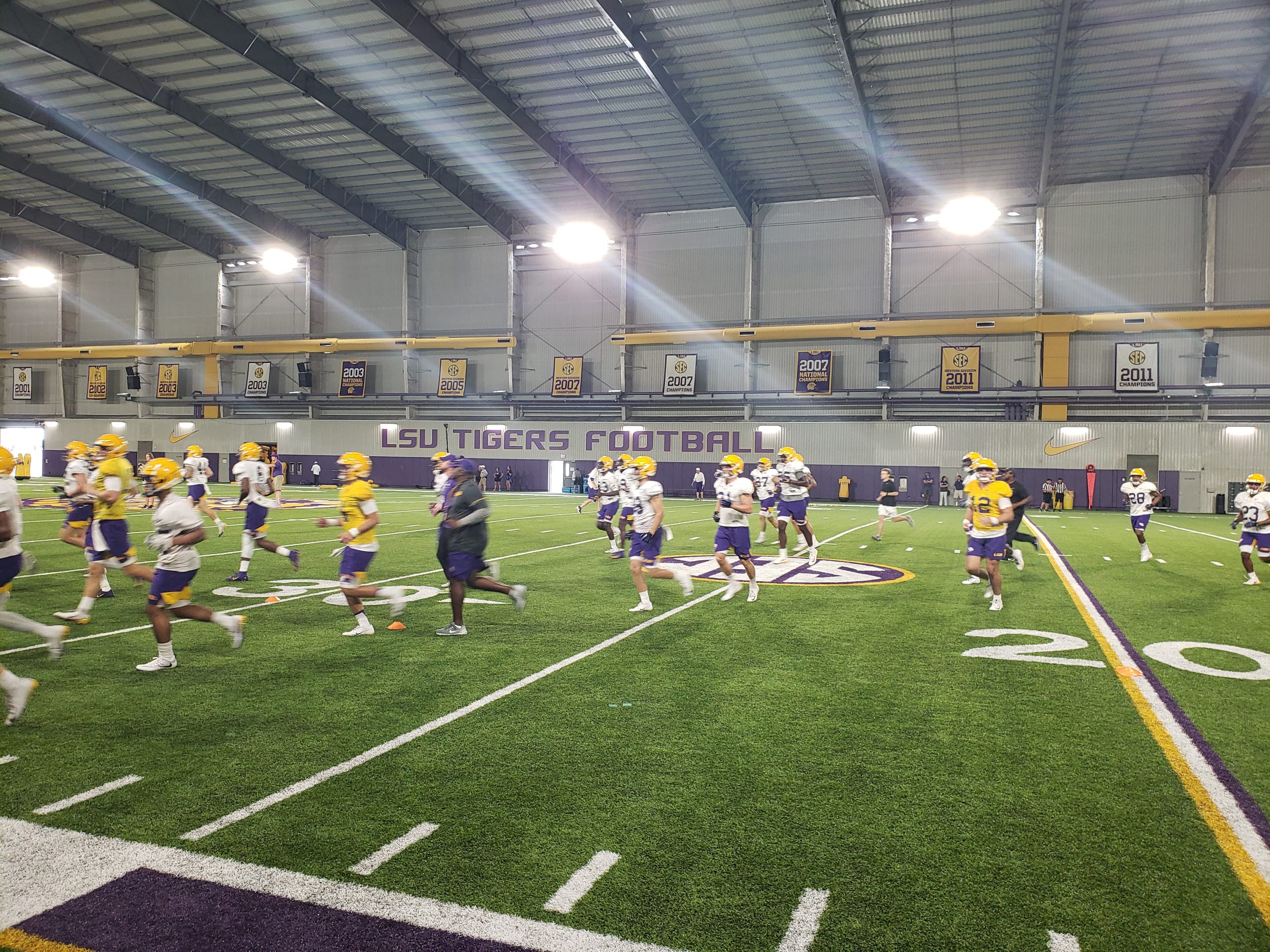
By CODY WORSHAM
Tiger Rag Editor
Branden Jenkins’ briefest SEC outing so far, a few seconds in LSU’s 88-77 win at Missouri, was short on minutes but ample in message.
Jenkins’ day in Columbia was so short he registered the rare 0+ in the minutes played column of the box score, which also revealed Jenkins tallied two fouls. But what the box score didn’t include was the meaning behind those fouls.
“I felt like the guys weren’t being aggressive enough,” he laughed, “so I came in with two quick fouls.”
Jenkins might only have been half kidding. Out of action for all of pre-conference play with a knee injury from which he’s only now just recovering, he’s seen – mostly from the sidelines – the devolution of a defense that ranks as the worst in the Johnny Jones era at LSU, and one of the worst in recent Tiger hoops history.
The deeper you dig into the numbers, the worse things look for the Tigers (9-5, 1-2 SEC). Adjusted for pace, LSU’s defensive rating is 104.5, according to KenPom.com, the school’s worst figure since 2002, the latest available calculations for the statistic. That ranks 205th nationally, and the Tigers’ 117.6 rating in SEC play is 12th in the league.
LSU is allowing its Power 5 opponents to score 19.975 points above their season averages and ranks 13th in the SEC in points per game allowed (77.2) and 14th in field goal percentage defense (44.9) and scoring margin (+0.1). Three of LSU’s last four opponents have enjoyed a half of 50 points or more.
#LSU is on pace to have its worst defense in the Johnny Jones Era. pic.twitter.com/dFtLnVtg1j
— Cody Worsham (@CodyWorsham) January 8, 2017
“There are some areas of concern that aren’t new to us, but defensively there are areas where we have to continue to grow, get better, and be more consistent,” Jones said. “It’s a must for us and it’s an area that we have to continue to work on.”
THE PROBLEMS
The most glaring problem with the Tigers’ defense is the amount of uncontested looks they’re surrendering. At Monday’s luncheon at L’Auberge in Baton Rouge, Jones said he’s watched replays of the games and been baffled by announcers concerned with the amount of uncontested looks LSU has surrendered.
“Even when guys are guarded,” he said, “they’re making shots.”
The numbers say those guys aren’t guarded closely enough, though. According to Synergy Sports, LSU has given 114 points on uncontested spot up shots, the most in the SEC. That was particularly evident against Mississippi State. The Bulldogs feasted on open looks, for a variety of reason.
First: miscommunication. Here, Aaron Epps doubles Quindarry Weatherspoon, State’s leading scorer, in the post, leaving his man. When he goes to recover, he and Duop Reath get their signals crossed, and both go to Epps’ man. This leaves Skylar Mays on an island when Reath’s man sets a ball screen, leading to a layup at the rim.
“Talking and pointing is a big thing and we don’t get enough of that,” said Jones. “I think when you get better at that your team becomes better. That’s an area where we have to get better. Some guys aren’t comfortable with it; it’s not who they are and it’s not a part of their makeup, but we have to get some of that to change.”
Then, there’s issues with scouting and personnel. Here, Lamar Peters, shooting well over 40 percent from 3 on the season, comes off a basic pin down screen. Brandon Sampson tries to cheat over the top, and Peters flares out for an open 3. This goes down as a ‘contested’ look, but Peters should never be allowed to catch and shoot in this sort of rhythm.
The scouting report should, and likely did, tell Sampson to trail Peters – that is, follow behind him through the screen. This forces Peters, who is only 5-foot-11, to drive into the paint and try to shoot over 6-foot-10 Duop Reath, a favorable matchup for LSU.
Finally, there are basics like ball pressure and getting numbers back in transition that the Tigers did poorly against State. LSU took a 20-19 lead in the first half, and State responded with a 26-7 run. Of those 26 points, 10 came on five layups in transition, when LSU simply didn’t get guys back.
Here, Skylar Mays drives to the rim. As the point guard, he’s the “get back” guy who is responsible for getting back to stop any sort of fast break. But when he drives, his teammates have to recognize this and cover for him. They don’t.
Number 3 for State liked that first layup so much, he decided to have another, this one off an LSU turnover.
State outscored LSU 25-10 on points off turnovers, even though both teams had 14 turnovers.
“Our bad offense created good offense for them,” said Blakeney.
THE SOLUTIONS
Jones and Jenkins both agreed that the communication issues can and should be fixed. Same goes for executing the scouting report. These are relatively easy fixes.
“Communication don’t cost anything,” Jenkins said. “You just gotta open your mouth. If they want to win, they’ll open their mouth. If they want to lose, they’ll continue to keep their mouth closed.”
“Guys gotta open their mouth and say something. We’ve got to take the scouting report serious and know what the defensive assignments are.”
One simple solution? Lineup changes. Jones heavily indicated he’d play a more defensive-minded team to start vs. A&M on Wednesday.
“We’re not concerned with offense as much because we have guys who are capable of taking care of the ball,” Jones said. “Defensively is something that I think has to be a main stay where you get better. It requires a lot more discipline and a lot more want to. A lot of times you don’t get your name in the paper because of what you do, but your team will because it’s the difference between winning and losing and that’s the separation we’ve got to get. So it’s more so on the defensive end of the floor. We think all of our guys are capable scorers, but we have to get guys who are tone setters on the defensive end of the floor.”
Jenkins, certainly, is one of them. Despite being just “85 percent” due to the knee injury that kept him sidelined through pre-conference play, he’s showed he’s an impact player on that end. LSU recruited him, largely, because of his prowess on that end. He had a +/- of minus-2 in 13 minutes against State, the second best figure on the team, and LSU was 20 points per 100 possessions better on defense when he played, per Open Look Analytics. In a very small sample size, he’s only given up 0.75 points per possession when he’s the primary on ball defender for LSU, per Synergy Sports.
“You just have to have that will know that your guy is not going to score on you,” he says. “If you’re a competitor, you want that. You don’t want nobody to score on you. You just gotta have that dog in you.”
Another player who’s drastically improved on defense is Kieran Hayward, who was the only player without a negative +/- vs. State (even in 14 minutes). He’s giving up just 0.698 points per possession when the primary defender, second only to Jalyn Patterson among all Tigers. LSU gives up just 1 point per possession as a team when he plays. That’s the best for any individual Tiger in the rotation.
This, from a player who arrived with little knowledge of college defensive rotations. Hayward looked behind the curve in fall practices on defense, struggling to grasp some concepts, but his coaches and teammates say he’s worked relentlessly to improve, and it shows.
“He’s really focused on that end,” said Blakeney. “He’s showed some of the older (players) how it needs to be done sometimes.”
“Kieran Hayward has done an excellent job from his first day on campus to now of improving in a lot of ways, including the defensive end of the floor,” said Jones. He’s a guy who I think expends the energy and at least puts forth the effort that’s needed for us. He’s obviously got a ways to go but it’s a great start.”
The best defensive lineup LSU had vs. State was Patterson-Hayward-Jenkins-Sims-Reath. In five possessions, they gave up just four points – a limited sample size, to be sure, but 25 points per 100 possessions better than LSU’s season average.
There are many defensive issues plaguing LSU at the moment. The good news is that most are easily fixed. A little more ball pressure, a little more intensity, and a little more talking all go a long way. The bad news, though, is that those problems have plagued LSU for four games now. If they’re not fixed soon, the next four could be just as bad.




Be the first to comment